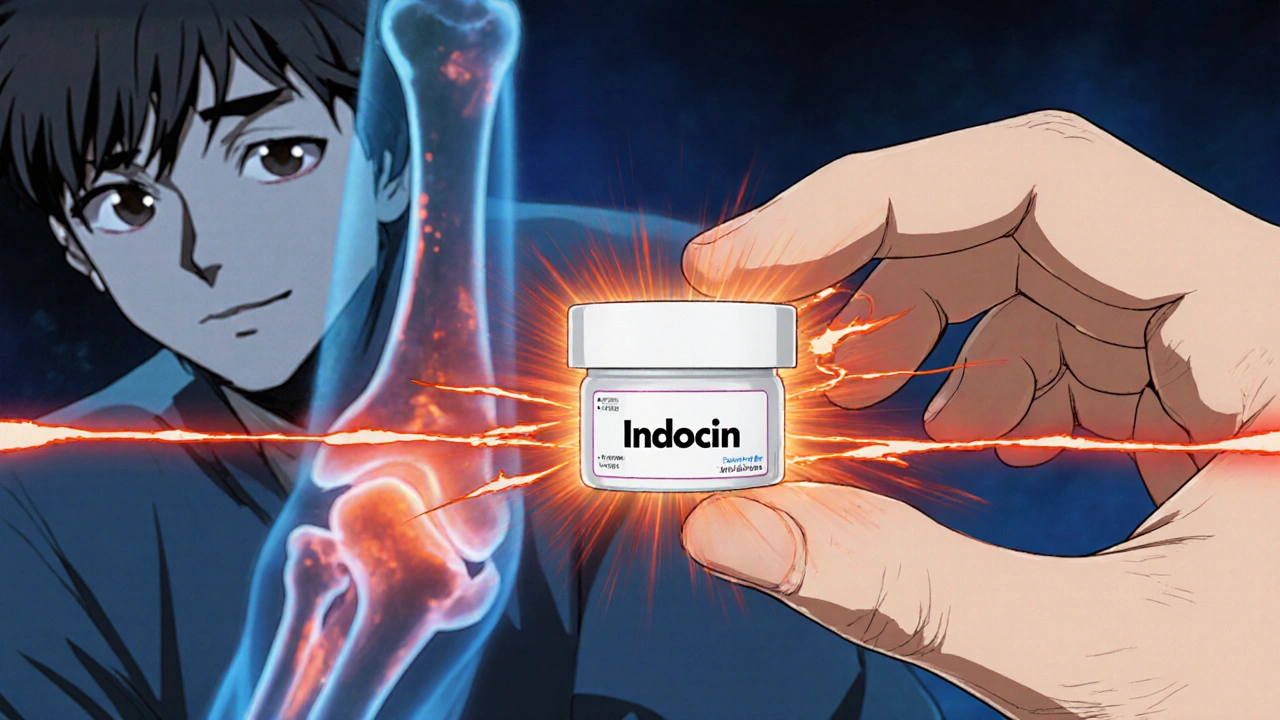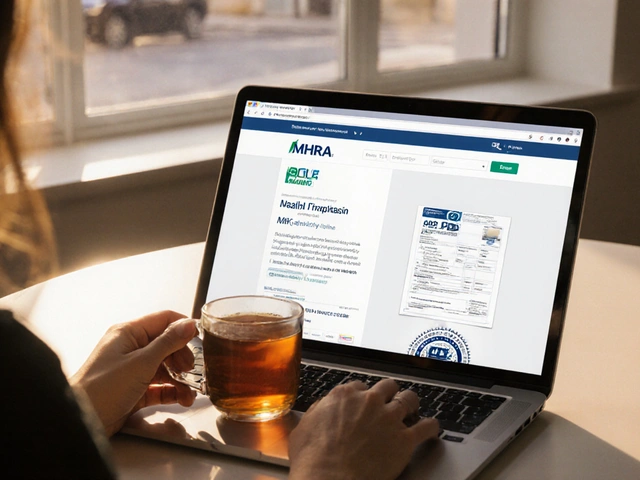Indocin is a prescription NSAID (nonsteroidal anti-inflammatory drug) used to treat pain, swelling, and stiffness caused by arthritis, gout, bursitis, and other inflammatory conditions. Its active ingredient is indomethacin, a powerful drug that works by blocking the body’s production of prostaglandins - chemicals that trigger inflammation and pain. Unlike over-the-counter pain relievers like ibuprofen or naproxen, Indocin is stronger and comes with stricter usage rules. It’s not something you pick up at the pharmacy without a doctor’s approval.
How Indocin Works in the Body
When you get injured or develop arthritis, your body releases prostaglandins. These molecules signal pain and cause swelling around joints, muscles, and tissues. Indocin stops an enzyme called cyclooxygenase (COX) from making prostaglandins. Less prostaglandins means less pain and inflammation. This is why doctors prescribe it for conditions like rheumatoid arthritis, where inflammation is constant and damaging.
But it doesn’t just target the bad prostaglandins. It also reduces the ones that protect your stomach lining and help with kidney function. That’s why side effects like stomach ulcers, bleeding, or kidney issues can happen - especially if you take it for long periods or at high doses.
Common Uses of Indocin
Indocin isn’t just for arthritis. It’s used in several specific medical situations:
- Rheumatoid arthritis: Reduces joint swelling and morning stiffness in adults.
- Osteoarthritis: Helps with pain when other NSAIDs don’t work well enough.
- Acute gout attacks: Often used when colchicine or corticosteroids aren’t suitable. It can bring down severe joint pain within 24 to 48 hours.
- Ankylosing spondylitis: Helps with spine and pelvic joint inflammation.
- Bursitis and tendinitis: Especially effective for shoulder or hip inflammation.
- Patent ductus arteriosus (PDA) in premature infants: A rare but critical use - doctors give it intravenously to close an abnormal blood vessel in newborns’ hearts.
It’s not used for headaches, colds, or minor injuries. It’s a targeted tool for moderate to severe inflammation that doesn’t respond to milder options.
Dosage and How to Take It
Indocin comes in capsules, extended-release capsules, suppositories, and oral suspension. The usual adult dose for arthritis is 25 mg two or three times a day. Doctors often start low - 25 mg once daily - then increase slowly to find the lowest effective dose.
Extended-release capsules (Indocin SR) are taken once a day, usually with food to reduce stomach upset. You should never crush or chew them. Suppositories are used when someone can’t swallow pills - like after surgery or during a severe gout flare.
For premature infants with PDA, the dose is calculated by weight and given in a hospital under strict monitoring. A typical dose is 0.2 mg/kg, followed by two more doses 12 and 36 hours later.
It can take up to a week to feel the full effect. Don’t double up if you miss a dose. If it’s almost time for the next one, skip the missed dose. Never take more than 200 mg per day unless directed by your doctor.
Side Effects: What to Watch For
Most people tolerate Indocin okay at low doses for short periods. But side effects are common - and sometimes serious.
Mild side effects:
- Upset stomach, nausea, vomiting
- Diarrhea or constipation
- Dizziness or headache
- Ringing in the ears
- Blurred vision
Serious side effects (call your doctor immediately):
- Black, tarry stools or vomiting blood (signs of stomach bleeding)
- Severe stomach pain or heartburn
- Swelling in legs, ankles, or feet (fluid retention)
- Shortness of breath or chest pain (possible heart issue)
- Yellowing of skin or eyes (liver problems)
- Sudden weight gain or reduced urination (kidney trouble)
People over 65, those with a history of ulcers, heart disease, or kidney problems are at higher risk. Alcohol increases stomach bleeding risk. Smoking makes side effects worse.

Who Should Avoid Indocin
Indocin isn’t safe for everyone. You should not take it if:
- You’ve had an allergic reaction to aspirin, ibuprofen, or other NSAIDs
- You’re in the third trimester of pregnancy - it can cause heart problems in the baby and delay labor
- You have active stomach ulcers or bleeding
- You’ve had a heart attack, stroke, or severe heart failure
- You’re on blood thinners like warfarin - the combination raises bleeding risk
- You have severe kidney or liver disease
Also, don’t use it if you’re breastfeeding without talking to your doctor. Indomethacin passes into breast milk and could affect the baby.
Drug Interactions to Know
Indocin doesn’t play well with many common medications. Here are the biggest risks:
- Anticoagulants (warfarin, rivaroxaban): Increased risk of dangerous bleeding.
- ACE inhibitors (lisinopril, enalapril): Indocin can reduce their blood pressure-lowering effect and harm kidney function.
- Diuretics (furosemide): Both can stress the kidneys. Fluid loss and electrolyte imbalances are common.
- Lithium: Indocin can raise lithium levels to toxic amounts.
- Methotrexate: Risk of bone marrow suppression and severe side effects.
- SSRIs (fluoxetine, sertraline): Combined use increases bleeding risk, even in the stomach.
Always tell your doctor about every supplement, herb, or OTC drug you take - including aspirin, fish oil, or ginger pills. They can interact too.
Alternatives to Indocin
If Indocin causes too many side effects or doesn’t work, there are other options:
| Medication | Strength | Typical Dose | Stomach Risk | Best For |
|---|---|---|---|---|
| Indocin (indomethacin) | High | 25-75 mg 2-3x/day | Very High | Severe gout, refractory arthritis |
| Naproxen (Aleve, Naprosyn) | Moderate | 250-500 mg 2x/day | Medium | Chronic arthritis, tendonitis |
| Diclofenac (Voltaren) | High | 50 mg 2-3x/day | High | Osteoarthritis, ankylosing spondylitis |
| Celecoxib (Celebrex) | Moderate | 100-200 mg once/twice daily | Low | Patients with stomach sensitivity |
| Corticosteroids (prednisone) | Very High | 5-20 mg/day | Low | Short-term flare control |
Celecoxib is often chosen for people with a history of stomach problems because it’s a COX-2 inhibitor - it targets inflammation more selectively. But it carries its own heart risks and isn’t for everyone.
For long-term management, doctors sometimes combine NSAIDs with physical therapy, weight loss, or disease-modifying drugs like methotrexate - especially for rheumatoid arthritis.
How Long Can You Take Indocin?
There’s no one-size-fits-all answer. For acute gout, you might only need it for 5 to 7 days. For chronic arthritis, some people take it for months or even years - but only under close medical supervision.
Long-term use increases the risk of kidney damage, high blood pressure, and heart problems. Most doctors prefer to use the lowest dose possible and regularly check kidney and liver function with blood tests. If you’re on Indocin for more than three months, you should have blood work every 3 to 6 months.
Never stop Indocin suddenly if you’ve been taking it for weeks. Your inflammation could rebound badly. Your doctor will guide you on how to taper off safely.
What to Do If You Think It’s Not Working
Some people expect pain relief within a day. Indocin doesn’t always work that fast. It can take up to a week to reach full effect. If you don’t notice improvement after 7 days, talk to your doctor - don’t just take more.
There are several reasons it might not work:
- You’re not taking it consistently (missed doses reduce effectiveness)
- Your condition has changed (e.g., new joint damage)
- You have an underlying infection or other cause of pain
- You’re taking something that interferes with it
Your doctor may switch you to another NSAID, add a corticosteroid injection, or consider a biologic medication if you have autoimmune arthritis.
Storage and Handling
Keep Indocin at room temperature - between 68°F and 77°F (20°C to 25°C). Avoid moisture and heat. Don’t store it in the bathroom. Keep it out of reach of children and pets.
Suppositories should be refrigerated. If they soften in warm weather, put them in the fridge for 10-15 minutes before use. Never freeze them.
Dispose of expired or unused pills properly. Don’t flush them. Take them to a drug take-back program or follow FDA disposal guidelines.
Can I take Indocin with Tylenol?
Yes, you can take Indocin with acetaminophen (Tylenol). They work differently - Indocin reduces inflammation, while Tylenol only relieves pain and fever. Many people use both together for better control. But don’t exceed 3,000 mg of acetaminophen per day, and avoid alcohol. Always check with your doctor first.
Does Indocin cause weight gain?
Indocin doesn’t directly cause fat gain, but it can lead to fluid retention, which makes you feel bloated or see the scale go up. This is more common in people with heart or kidney issues. If you gain more than 2-3 pounds in a week, tell your doctor - it could be a sign your kidneys are struggling.
Is Indocin stronger than ibuprofen?
Yes, Indocin is significantly stronger than ibuprofen. A typical dose of Indocin (25 mg) is about 5 to 10 times more potent than a standard 200 mg ibuprofen tablet. That’s why it’s prescription-only. It’s more effective for severe inflammation, but also carries higher risks.
Can Indocin cause high blood pressure?
Yes. Like most NSAIDs, Indocin can raise blood pressure, even in people who’ve never had hypertension. If you’re on blood pressure medication, your doctor should monitor your numbers closely. Check your BP at home if possible, especially during the first few weeks of treatment.
How long does Indocin stay in your system?
The half-life of indomethacin is about 4.5 hours, meaning half of it leaves your body in that time. But it takes around 24 to 48 hours for nearly all of it to be cleared. If you stop taking it, pain and inflammation may return within a day or two, which is why it’s often taken multiple times a day.
Final Thoughts
Indocin is a powerful tool - but it’s not a casual pain reliever. It’s meant for specific, often chronic, inflammatory conditions where other drugs fall short. Used right, it can dramatically improve mobility and quality of life. Used wrong, it can cause serious harm.
If you’ve been prescribed Indocin, make sure you understand why. Ask your doctor about alternatives, how long you’ll need it, and what warning signs to watch for. Keep a journal of how you feel each day - note pain levels, side effects, and any changes in swelling or energy. That info helps your doctor adjust your plan.
Don’t let fear stop you from taking it if you need it. But don’t ignore the risks either. The goal isn’t just to reduce pain - it’s to do it safely, for as long as you need to.







